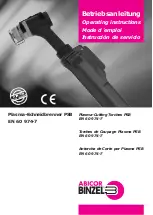
European Safety Systems Ltd.
Impress House, Mansell Road, Acton, London W3 7QH
www.e2s.com
Tel: +44 (0)208 743 8880
Document No. D211-00-651-IS
Issue 1
20-08-22
Sheet 3 of 8
Beacon
Cover
M4 Screws
(4-off)
Sounder
Cover
M4
Screws
(4-off)
5)
Special Conditions for Safe Use
Special Condition for safe Use as stated on the Type
Examination Certificate DEMKO 14 ATEX 4786493904X /
CoC IECEx ULD 14.0004X / UL21UKEX2131X:
When used for a Group III application, the surface of the
enclosure may store electrostatic charge and become a
source of ignition in applications with a low relative humidity
<~30% relative humidity where the surface is relatively free of
surface contamination such as dirt, dust, or oil.
Guidance on protection against the risk of ignition due to
electrostatic discharge can be found in EN TR50404 and IEC
TR60079-32.
End user shall adhere to the manufacturer’s installation and
instruction when performing housekeeping to avoid the
potential for hazardous electrostatic charges during cleaning,
by using a damp cloth.
To maintain the ingress protection rating and mode of
protection, the cable entries must be fitted with suitably rated,
certified cable entry and/or blanking devices during
installation.
Use heat resistant cables and glands (rated 95°C)
6)
Product Mounting and Access
6.1. Location and Mounting
The location of the combined alarm horn and beacon should
be made with due regard to the area over which the warning
signal must be visible and audible. It should only be fixed to
services that can carry the weight of the unit.
D2xC2 Combined unit should be fitted to a flat surface via the
two 9.7 x 6.7mm, 147mm pitch fixing holes in the mounting
feet of the sounder section and the two 6.9mm, 116mm pitch
fixing holes in the feet of the base.
The equipment is not to be mounted with the horn facing
upwards.
Fig. 1 Fixing locations.
6.2. Access to the Enclosure
Warning – High voltage may be
present, risk of electric shock.
DO NOT open when energised,
disconnect power before opening.
Warning – Hot surfaces. External
surfaces and internal components
may be hot after operation, take
care when handling the equipment.
To access the enclosure, loosen the four M4 posi pan head
screws and withdraw the cover.
Fig. 2 Accessing Enclosures.
To replace cover, check that the ‘O’ ring seal is in place.
Carefully push the cover in place. Insert M4 screws with fiber
washers and tighten to 3Nm torque.
7)
Selection of Cable, Cable Glands, Blanking
Elements & Adapters
When selecting the cable size, consideration must be given to
the input current that each unit draws (see section 15), the
number of beacons on the line and the length of the cable runs.
The cable size selected must have the necessary capacity to
provide the input current to all of the sounders connected to the
line.
When selecting the cable size consideration must be given to
the voltage drop over the length of the cable run to ensure the
min. input voltage at the point of use (voltage range, see section
15)
The voltage drop depends on:
-
The total current draw of the devices installed on this
cable run
-
The wire size and total length of the cable run,
determining the total resistance of this cable run
-
The minimum output voltage supplied by the power
supply
The voltage drop and input voltage at the point of use can be
calculated as follows:
Total Wire resistance =
Wire resistance / 1000ft x length of cable run x 2
(length of cable run needs to be multiplied by two to account for
two wires going to and from the unit)
Total current draw =
Current draw per unit x number of units
Voltage Drop = Total current draw x Total wire resistance
147,0mm [5,73in.]
116,0mm [4,52in.]
21
3,
3m
m
[
8,
32
in
.]
165,6mm [6,46in.]
9,7mm [0,38in.]
6,
7
m
m
[
0,
2
6i
n
.]
Ø6,9mm [Ø0,27in.]
3
10
,3
m
m
[
1
2,
10
in
.]
125,0mm [4,88in.]
168,0mm [6,55in.]



































